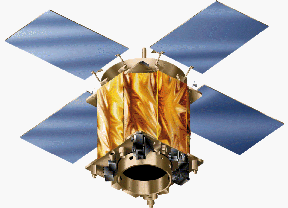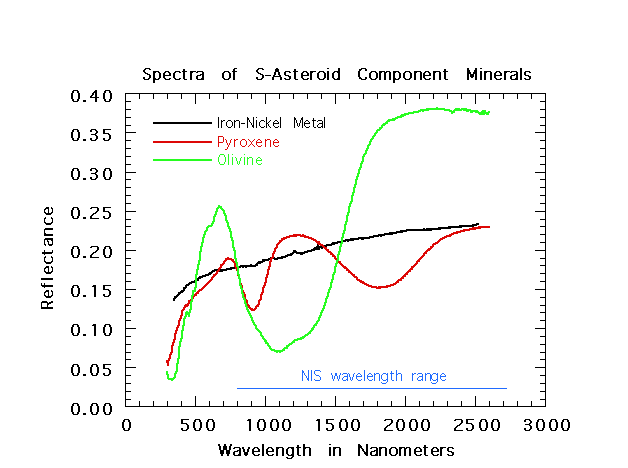

Near Earth Asteroid Rendezvous Near-Infrared Spectrograph (NIS)
Instrument Fact Sheet


The NIS Instrument
Near Earth Asteroid Rendezvous
The Near-Infrared Spectrograph (NIS), one of the five instruments on the NEAR spacecraft, is designed to map the mineralogic composition of the near-Earth asteroid 433 Eros using the spectrum of reflected sunlight. Spectra measured during approach, flyby, and orbit of Eros will cover surface regions as small as 300 meters in size. Each spectrum has 64 spectral channels covering the near-infrared wavelength region 800-2700 nm, which allows mapping of the mineral composition of Eros. NIS data will provide the main evidence for the rock types present at the asteroid's surface. Together with measurements of elemental composition from the X-ray/Gamma-ray Spectrometer (XGRS) and color imagery from the Multispectral Imager (MSI), NIS data will provide a link between asteroids and meteorites and clarify the processes by which asteroids formed and evolved.
Specifications
Mass: Spectrometer, 10.15 kg
Electronics, 5.0 kg
Power: Spectrometer, 4.3 W
Electronics, 10.8 W
Instantaneous adjustable to 0.38deg. x 0.76deg. or 0.76deg. x 0.76deg.;
field of view: 0.65 x 1.3 km or 1.3 x 1.3 km from a 100 km distance
Total field of view: scannable over 140deg. in 1 axis; second dimension
obtained by spacecraft motion
Integration time: 1 second; on-board summation of up to 16 spectra
Detectors and 32-element Ge array: 804-1506 nm in 21.6-nm increments;
wavelength range: 32-element InGaAs array: 1348-2732 nm in 43.1-nm increments
Data Character: 64 channels, 12 bits per channel, summable to 16 bits
The NEAR Near-Infrared Spectrograph (NIS) is a scanning spectrometer that measures near-infrared light in the wavelength range 800-2700 nm. A gold scan mirror that rotates over an angle of 140deg. controls the direction of viewing. Light reflected from the scan mirror enters through either of two shutters that provides a 0.38deg. x 0.76deg. or 0.76deg. x 0.76deg. field-of-view, to accommodate different illumination conditions. These provide spot sizes of 0.65 x 1.3 km or 1.3 x 1.3 km from a 100 km distance. The light is dispersed off a diffraction grating onto two detectors. A 32-element germanium (Ge) detector measures the wavelengths 804-1506 nm in 21.6-nm increments; a 32-element indium-gallium arsenide (InGaAs) detector measures the wavelengths 1348-2732 nm in 43.1-nm increments. The gain of the Ge detector is settable at 1x or 10x, to accommodate various illumination conditions. A movable shutter can block the aperture to provide calibration measurements of the background dark level. A solar-illuminated gold calibration target is viewable for radiometric calibration. Individual spectra consist of 12-bit measurements, and up to 16 individual spectra for one spot can be summed on-board. Mirror scanning combined with spacecraft motion will be used to build up spectral images. The computer (digital processing unit, or DPU) is shared with the NEAR magnetometer, and provides the software to control instrument function.
Near-Infrared Spectroscopy at Eros
The compositions of asteroids are measured using the spectrum of reflected sunlight. Different minerals have characteristic reflectance spectra which serve as "fingerprints" for their identification. "S" asteroids, including 433 Eros, are composed mostly of iron-containing silicates (the minerals olivine and pyroxene) and metal (an iron-nickel alloy). However the mineralogies of different S-asteroids span a wide range. Meteorite types having these mineralogies have divergent histories: some have remained largely pristine since the beginning of the solar system, while others consist of extremely ancient volcanic rocks, and still others have melted and cooled inside large parent asteroids. The correspondence between different types of meteorites and the different kinds of S asteroids remains unknown. Resolving this issue will provide an understanding of the processes that occurred early in the solar system and led to the formation of asteroids and meteorites.

Representative Asteroid Mineral Spectra
433 Eros is in the middle of the range of mineralogic variation among S asteroids. In this sense it is a "representative sample" of these bodies. However earth-based spectroscopic studies show that different parts of Eros have different abundances of minerals; that is, Eros contains different types of rocks. The compositions and especially the natures of the boundaries between different rock types are key pieces of evidence for how they formed.

Groundbased Telescopic Spectra of Eros
NEAR's battery of instruments is designed to measure the composition and compositional variations of Eros's surface using different, complementary strategies. NIS is the key to this approach. NIS data will be used to map the distribution and abundance of minerals, at scales as small as 300 meters. The Multispectral Imager (MSI) has additional spectroscopic capabilities, at 70 times the spatial resolution of NIS. That instrument will allow compositional measurements from NIS to be extrapolated down to the scale of meters, revealing details of the physical interrelationship of discrete materials identified by NIS. The X-ray/Gamma-ray Spectrometer (XGRS) measures the distribution and abundance of elements. Measurements from XGRS, together with NIS's measurement of the distribution and abundance of minerals, will allow definitive identification of the rock types composing Eros. This information together will be used to synthesize the history of geologic processes that formed Eros, and how the materials on Eros are related to meteorites.
Experiment Profile
The NEAR spacecraft will follow a 2-year [[Delta]]VEGA trajectory beginning with a launch in February 1996. After slowly approaching and flying by Eros in February 1999, the spacecraft will be inserted into orbits of progressively lower radii, culminating in a 35-km low orbit. NIS will return spectroscopic measurements during approach, flyby, and orbit at progressively higher spatial resolutions. This first high resolution mineralogic mapping investigation of an asteroid will finally clarify the composition and geologic variety of an asteroid, and shed light on what processes have produced the asteroids and meteorites.
NIS Team
Science: Joseph Veverka (Cornell Univ.), Team Leader
James F. Bell, III (Cornell Univ.)
Clark R. Chapman (Planetary Science Institute)
Michael C. Malin (Malin Space Science Systems)
Lucy-Ann A. McFadden (Univ. of Maryland)
Mark S. Robinson (U. S. Geological Survey)
Peter C. Thomas (Cornell Univ.)
Lead Engineer: Jeffery W. Warren (JHU/APL)
Instrument Scientists: Noam R. Izenberg and Scott L. Murchie (JHU/APL)
Payload Manager: Robert E. Gold (JHU/APL)